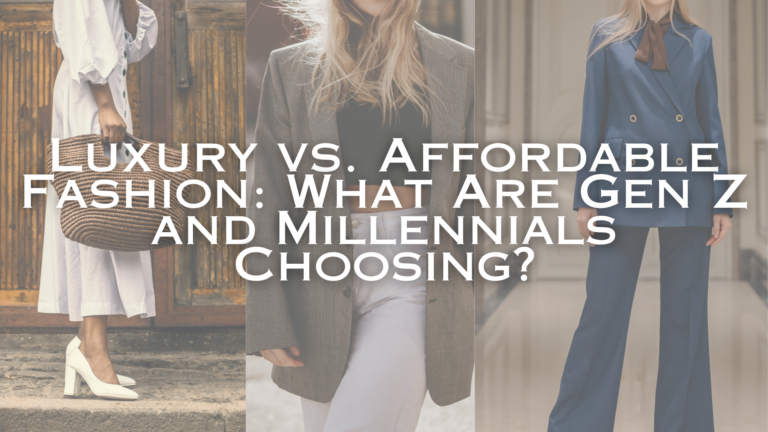
1. Introduction
Fashion choices have always reflected more than just style — they show values, aspirations, and cultural identity. Today, two of the most influential consumer groups, Gen Z (born 1997–2012) and Millennials (born 1981–1996), are reshaping the fashion landscape. Their purchasing behavior, especially when it comes to luxury vs. affordable fashion, is turning the industry on its head. Are these generations gravitating towards high-end designer pieces, or do they favor fast, functional, and budget-friendly fashion? This article breaks down the trends, behaviors, and motivations behind their fashion choices.
2. Understanding the Generations: Gen Z vs Millennials
While both groups are digitally native and socially conscious, their attitudes toward fashion differ slightly:
- Gen Z: Grew up with social media, deeply value authenticity, and are more open to thrifted and upcycled fashion.
- Millennials: Value quality and tend to lean towards investments in timeless pieces, especially as they age into higher income brackets.
Both generations want to express themselves through their clothes — but how they do it and how much they’re willing to pay vary.
3. Luxury Fashion: The Appeal and the Shift
Luxury fashion was once synonymous with exclusivity and prestige. Brands like Gucci, Louis Vuitton, and Chanel have long been aspirational for younger consumers. But Gen Z and Millennials are redefining what “luxury” means.
Why Millennials Still Invest in Luxury
- Status symbol for success and career growth
- Perception of higher quality and longevity
- Greater spending power and interest in timeless fashion
Gen Z’s Take on Luxury
- Less concerned with brand status, more focused on ethical values and individuality
- Prefer vintage or second-hand luxury to avoid overconsumption
- Prioritize sustainability and resale value
🛍 Interesting stat: A 2023 Bain & Company study showed that Gen Z drives 20% of luxury purchases, mostly through resale platforms like The RealReal or Vestiaire Collective, rather than new.
4. Affordable Fashion: Fast, Accessible, and Evolving
Affordable or fast fashion brands like H&M, Zara, and Shein have exploded due to their trend-focused, low-cost offerings. While these brands have been criticized for unethical practices, their appeal still holds — especially for fashion-conscious younger buyers.
Why It Still Works
- Enables quick access to the latest trends
- Ideal for social media-driven aesthetics (Instagram, TikTok)
- Appeals to students and early professionals with limited budgets
However, both Gen Z and Millennials are becoming increasingly critical of fast fashion’s environmental impact, prompting many to seek out affordable alternatives with better ethics, such as Uniqlo, Everlane, or Thrift+.
5. What Drives Their Choices?
a. Sustainability
Gen Z in particular sees sustainability not as a trend, but a requirement. They’re ditching fast fashion for thrifted and recycled options. Millennials are catching up, especially in parenting years.
b. Value for Money
Even luxury-loving Millennials appreciate brands that last longer. Gen Z wants a balance — trendy items for the moment, but they’re willing to pay more for a sustainable or ethical option.
c. Social Media Influence
Influencers have changed the game. TikTok and Instagram made micro-trends go viral overnight — which affordable brands capitalize on. But now, luxury brands are also collaborating with influencers and creators (e.g., Gucci x Harry Styles) to stay relevant.
d. Personal Expression
Gen Z doesn’t follow trends — they create them. They value unique, expressive outfits more than blindly following mainstream trends. Luxury brands that don’t adapt to this mindset risk becoming outdated.
6. The Rise of High-Low Dressing
One of the biggest style shifts is the blending of luxury with affordable fashion. It’s no longer all high-end or all fast fashion — it’s a mix.
👕 Example:
- Luxury bag (Chanel)
- Thrifted blazer
- H&M jeans
- Nike sneakers
This “high-low” mix shows that style is personal — not limited by price tags. Both generations love this method of styling, and brands are responding by releasing capsule collections, collaborations, and limited drops that bring luxury closer to affordability.
7. Top Brands Gen Z and Millennials Love
Here’s a look at the brands capturing attention in both segments:
| Brand | Gen Z Appeal | Millennial Appeal |
|---|---|---|
| Zara | Trend-focused, accessible | Sophisticated yet affordable |
| Shein | Massive trend turnover | Losing favor due to ethics |
| Everlane | Transparent pricing, sustainable | Quality basics, ethical |
| Gucci | Creative direction, inclusivity | Classic status symbol |
| ThredUp | Second-hand, affordable | Conscious closet refresh |
| Uniqlo | Minimal, functional | Reliable everyday wear |
| Balenciaga | Edgy, meme-worthy fashion | Bold statement investments |
| ASOS | Huge selection, affordable | Fashion-forward but practical |
8. Conclusion
So, what are Gen Z and Millennials choosing? The answer isn’t either luxury or affordable fashion — it’s both, in moderation and with intention.
These generations are no longer buying into the idea that you have to spend thousands to look stylish. Instead, they’re curating wardrobes that reflect their identity, ethics, and creativity — blending luxury splurges with affordable finds, and mixing vintage with new.
Brands that listen, adapt, and reflect the values of these consumers — from sustainability to self-expression — are the ones that will win. Whether it’s a thrifted coat or a Gucci belt, the new fashion rule is simple: Wear what feels right, not just what costs more.